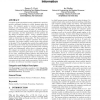21 search results - page 4 / 5 » The Model of Collaborative Learning GRID to activate interac... |
NN
2002
Springer
13 years 4 months ago
2002
Springer
Recognition-by-components is one of the possible strategies proposed for object recognition by the brain, but little is known about the low-level mechanism by which the parts of o...
ICRA
2005
IEEE
13 years 10 months ago
2005
IEEE
— Imitation is a powerful mechanism for transferring knowledge from an instructor to a na¨ıve observer, one that is deeply contingent on a state of shared attention between the...
WWW
2006
ACM
14 years 5 months ago
2006
ACM
The asymmetry of activity in virtual communities is of great interest. While participation in the activities of virtual communities is crucial for a community's survival and ...
KDD
2007
ACM
14 years 5 months ago
2007
ACM
Commercial datasets are often large, relational, and dynamic. They contain many records of people, places, things, events and their interactions over time. Such datasets are rarel...
ATAL
2008
Springer
13 years 7 months ago
2008
Springer
Computer agents participate in many collaborative and competitive multiagent domains in which humans make decisions. For computer agents to interact successfully with people in su...

